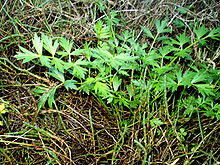Apium prostratum
| Sea celery | |
|---|---|

| |
| Scientific classification | |
| Kingdom: | Plantae |
| Clade: | Tracheophytes |
| Clade: | Angiosperms |
| Clade: | Eudicots |
| Clade: | Asterids |
| Order: | Apiales |
| Family: | Apiaceae |
| Genus: | Apium |
| Species: | A. prostratum
|
| Binomial name | |
| Apium prostratum | |
Apium prostratum,commonly known assea celery,is a variableherbnative to coastalAustraliaandNew Zealand.[1]The leaves are variable, with toothed leaflets, and a celery like aroma. The tiny white flowers occur in clusters.
There are two varieties:
- Apium prostratumvar.filiforme–headland sea celery,squat with broad leaves (2-3 times longer than wide)and grows on coastal dunes and headlands.
- Apium prostratumvar.prostratum–mangrove sea celery,upright with fine leaves (6-15 times longer than wide) and grows in swamps.[2][3]
ThesubspeciesApium prostratumsubsp.howenseis endemic toLord Howe Island.

Uses
[edit]Commonly eaten by Maori in New Zealand, for whom it is known as Tutae Koau, sea celery was also an important vegetable for early explorers and colonists in Australia and New Zealand.Captain Cookate sea celery atBotany Bayand gathered it in bulk along withLepidium oleraceumatPoverty BayinNew Zealandin October 1769 to protect his crew fromscurvy.[1]It was commonly eaten by colonists as a survival food in the early days of theSydneycolony.[2]
Both leaf and stem are eaten. Dried leaves are used in native Australianspicemixes. It tastes much the same as celery and is used to flavoursoups.Varietyfiliformeis considered to be more palatable.[2]
It was cultivated by colonists aroundAlbany,Western Australia,as a vegetable.[2]It is commercially cultivated to a limited extent.[citation needed]
References
[edit]- ^abWalter Reginald Brook Oliver."Sir Joseph Banks and Dr Solander (Cook's First Voyage)".Botanical Discovery in New Zealand: The Visiting Botanists.School Publications Branch, New Zealand Education Department. p. 7.Retrieved1 January2012.
- ^abcdLow, T. (1988).Wild Food Plants of Australia.Angus & Robertson.ISBN0-207-16930-6.OCLC25220546.
- ^"Sea Celery".Victorian resources Online.
External Links
[edit]- "Apium prostratumLabill. ex Vent. — Sea Celery ".Atlas of Living Australia.
- Apium
- Apiales of Australia
- Edible Apiaceae
- Bushfood
- Leaf vegetables
- Crops originating from Australia
- Crops originating from New Zealand
- Flora of New South Wales
- Flora of Queensland
- Flora of Victoria (state)
- Flora of Tasmania
- Flora of South Australia
- Eudicots of Western Australia
- Flora of the Antipodes Islands
- Plants described in 1804
- Apiaceae stubs
- Australian asterid stubs
